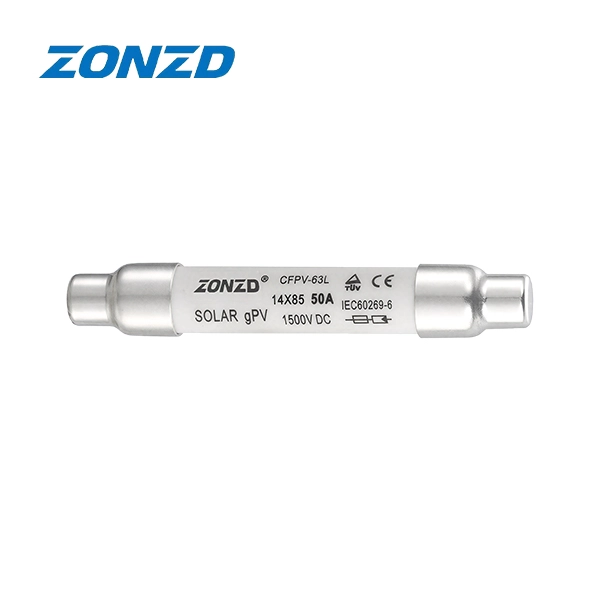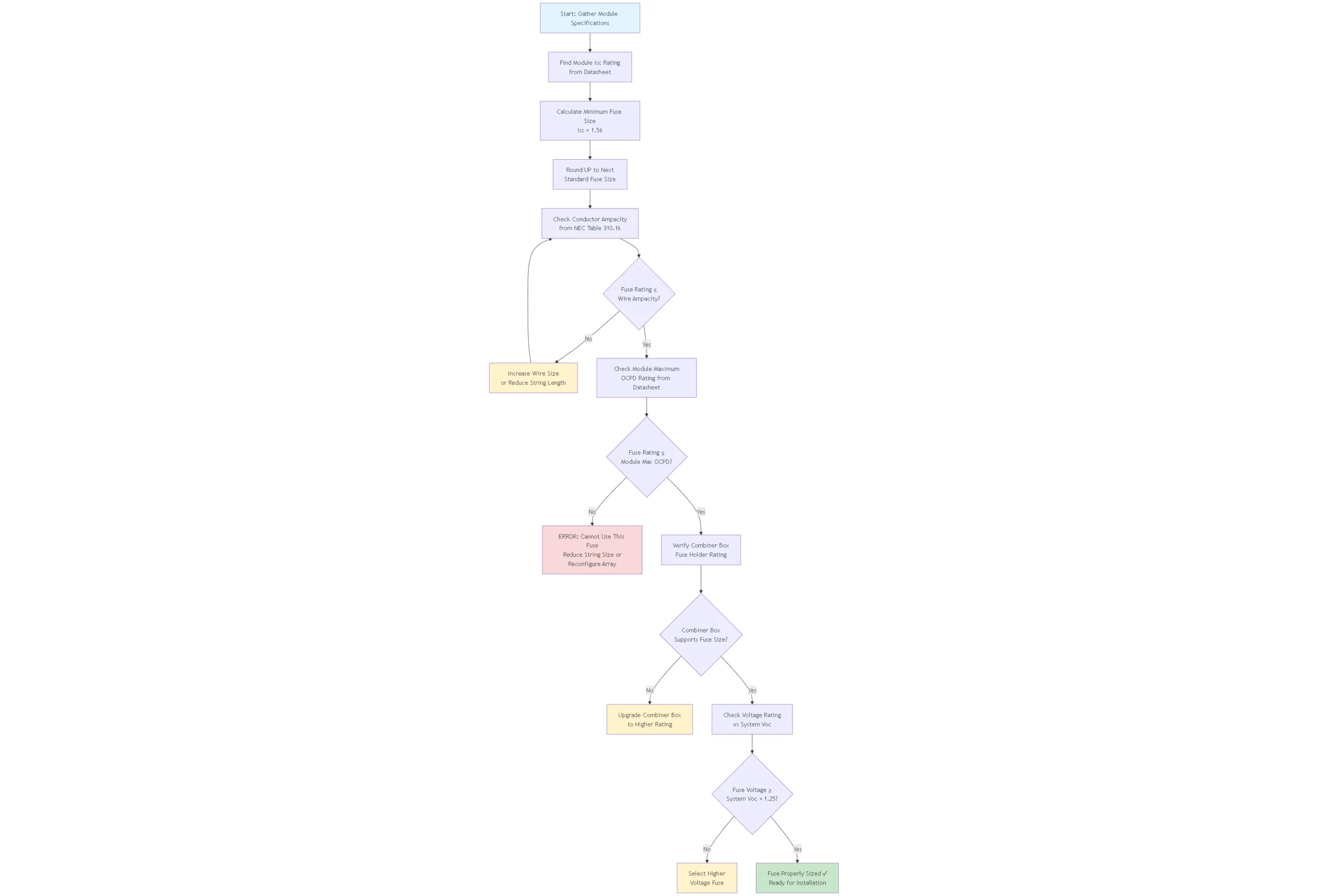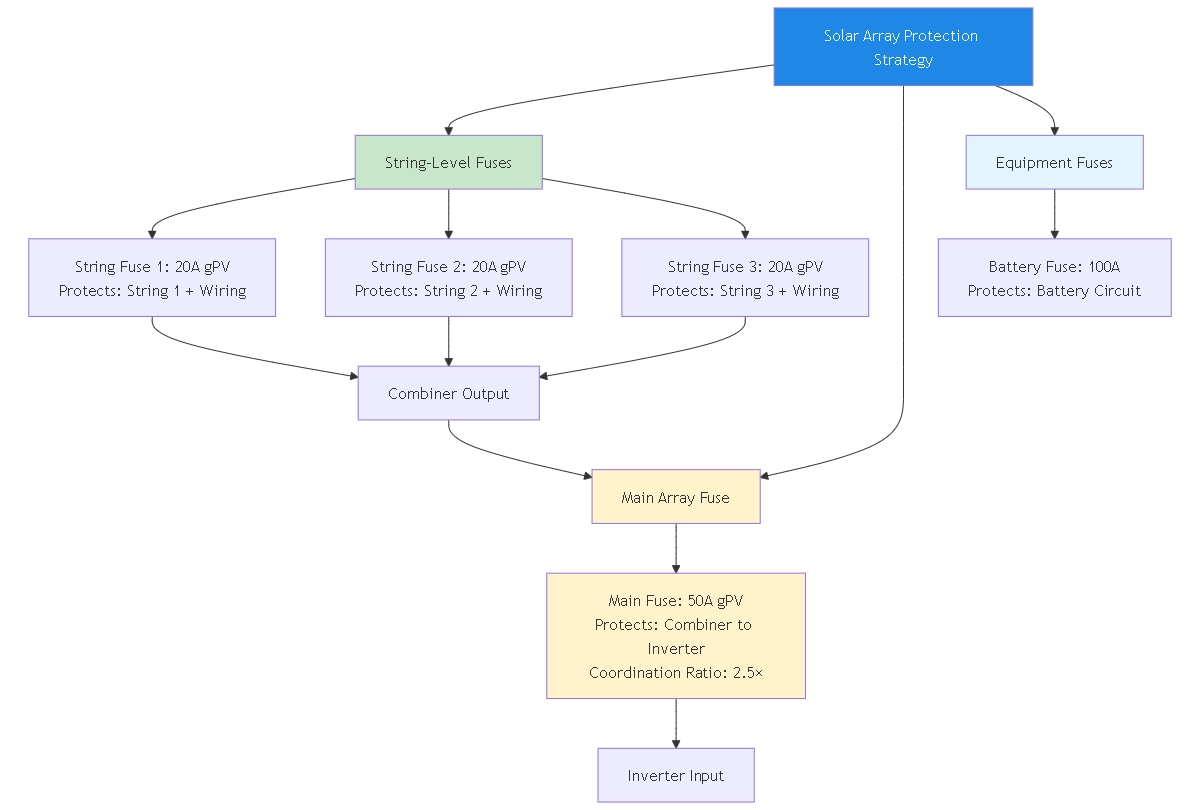Adresse
304 North Cardinal
St. Dorchester Center, MA 02124
Heures de travail
Du lundi au vendredi : de 7h00 à 19h00
Le week-end : 10H00 - 17H00
Adresse
304 North Cardinal
St. Dorchester Center, MA 02124
Heures de travail
Du lundi au vendredi : de 7h00 à 19h00
Le week-end : 10H00 - 17H00

A solar panel fuse provides critical overcurrent protection that prevents equipment damage and fire hazards in photovoltaic systems. Understanding proper solar panel fuse selection, sizing, and installation ensures your PV array operates safely while meeting National Electrical Code requirements and protecting your investment in solar energy.
This comprehensive guide covers everything installers and system designers need to know about solar panel fuses, from gPV ratings and sizing calculations to common installation mistakes that void warranties and create safety risks.
Solar panel fuses must handle unique DC electrical characteristics that standard AC fuses cannot safely interrupt. When protecting photovoltaic equipment, specialized Fusibles DC designed for solar applications ensure reliable protection under challenging operating conditions.
Key differences from AC fuses:
DC arc extinction challenges become significantly more difficult than AC protection. In AC circuits, current naturally crosses zero 120 times per second, helping extinguish arcs. DC current maintains constant polarity, creating sustained arcs that require specialized fuse designs to safely interrupt.
Photovoltaic-specific gPV ratings address solar array characteristics including reverse current conditions, high surge currents during cloud-edge effects, and the unique I-V curve behavior of PV modules. Standard fuses lack the testing and construction needed for these scenarios.
Temperature coefficients affect fuse performance differently in rooftop installations where ambient temperatures can exceed 70°C (158°F). Solar-rated fuses undergo testing at extreme temperatures to ensure reliable operation in hot attic spaces and roof-mounted combiner boxes.
💡 Aperçu clé : Selon le IEC 60269-6 standards, gPV-rated fuses must pass 22 specific tests including reverse current interruption and maximum power point tracking scenarios that don’t apply to general-purpose DC fuses.
The “gPV” designation indicates a fuse specifically designed and tested for photovoltaic applications. This rating, defined in IEC 60269-6 and recognized by UL 2579, ensures the fuse safely protects solar arrays under all operating conditions.
What gPV certification guarantees:
The fuse can interrupt reverse currents flowing from a healthy string into a faulted string. In multi-string arrays, one shorted string can draw current from parallel strings, creating reverse current conditions that exceed forward operating current.
High voltage DC interruption capability at system voltages from 600V DC through 1500V DC. As utility-scale installations adopt 1500V architectures, fuse ratings must match or exceed maximum system voltage.
Coordination with module and conductor ratings ensures the fuse protects downstream equipment without nuisance operation. The fuse’s let-through energy (I²t rating) must be lower than cable and module withstand ratings.
⚠️ Important : Using non-gPV rated fuses in solar applications violates NEC Article 690.9 and creates serious safety hazards. Standard automotive or general-purpose DC fuses cannot safely interrupt PV fault currents and may explode under reverse current conditions.
Individual string fuses protect each solar array string in parallel configurations. NEC 690.9(A) requires overcurrent protection when three or more strings connect in parallel.
String fusing protects against:
Each string typically uses 10A to 20A fuses depending on module short-circuit current (Isc) ratings. The fuse sizing must account for the 1.56x multiplier required by NEC 690.8(A)(1).
Main array fuses or circuit breakers provide backup protection between the combiner box output and the charge controller or inverter input. This protection guards against:
Downstream equipment faults:
Main fuses typically range from 30A to 300A for residential through commercial systems. Proper coordination requires the main fuse to be rated higher than individual string fuses to ensure selective operation.
Additional fusing may be required at specific equipment locations:
Battery connections: Fuses between charge controller output and battery bank prevent battery short-circuit currents from damaging equipment. Battery fuses typically range from 100A to 400A depending on bank size.
DC optimizer systems: Some microinverter and optimizer architectures require module-level fusing, though many manufacturers use internal protection instead.
Monitoring equipment: Current sensors and monitoring circuits may need low-current fuses (typically 1A to 5A) for protection.
NEC 690.8(A)(1) requires sizing conductors and overcurrent devices at 156% of short-circuit current under standard test conditions. This accounts for:
Irradiance variation: Solar irradiance can exceed 1000 W/m² during cloud-edge effects where direct and reflected sunlight combine, temporarily boosting module output 15-25% above rated Isc.
Temperature effects: Cold, sunny winter days can increase Voc while maintaining high current output, stressing protection devices.
Aging factors: Module performance varies over time, and the multiplier provides safety margin for degradation patterns.
Calculation formula: Minimum fuse rating = Module Isc × 1.56
Example calculation:
Never round down when selecting fuse ratings. Using a 15A fuse in this example would violate code and create nuisance fuse operation during high-irradiance conditions.
While minimum sizing follows the 1.56x rule, maximum fuse size is limited by conductor ampacity and equipment ratings:
Conductor protection: Fuse rating cannot exceed the conductor’s ampacity per NEC 690.9(B). For 10 AWG USE-2 wire rated 40A, the maximum fuse would be 40A.
Module OCPD rating: Module datasheets specify maximum overcurrent protection device ratings, typically 15A to 25A for residential modules. Never exceed this rating even if wire size would permit it.
Combiner box rating: Fuse holders and busbars in combiner boxes have maximum current ratings that cannot be exceeded. Standard combiner boxes support 15A to 30A fuses per string position.
In series-only configurations (one or two strings), fusing may not be required per NEC 690.9(A). However, many installers include fusing for:
Servicing safety: Fused disconnect allows safe string isolation during maintenance without shutting down entire array.
Future expandability: Pre-installed fusing simplifies adding parallel strings later without system redesign.
Additional protection: Provides overcurrent protection for downstream wiring even in series-only configurations.

Solar fuses are available in standard current ratings that match common module configurations:
| Fuse Rating | Max Module Isc | Typical Application | System Size |
|---|---|---|---|
| 10A gPV | 6.4A | Older/smaller modules | Résidentiel |
| 15A gPV | 9.6A | Standard 300-350W modules | Residential/Small Commercial |
| 20A gPV | 12.8A | Modern 370-450W modules | Residential/Commercial |
| 25A gPV | 16.0A | High-power 500W+ modules | Commercial |
| 30A gPV | 19.2A | Main array protection | Residential 2-3 strings |
| 40A gPV | 25.6A | Main array protection | Commercial 3-4 strings |
| 50A gPV | 32.0A | Main array protection | Commercial 4-5 strings |
| 63A+ gPV | 40.4A+ | Large array mains | Utility-Scale |
Solar panel fuses must be rated for maximum system voltage with safety margin:
600V DC fuses: Residential systems (typical 300-450V maximum)
1000V DC fuses: Commercial systems (typical 600-850V maximum)
1500V DC fuses: Utility-scale systems (typical 1200-1400V maximum)
Always select fuse voltage rating at least 25% higher than maximum system open-circuit voltage (Voc) at lowest expected temperature. Cold sunny mornings can push Voc 15-20% above rated values.
The most common type for residential and commercial solar installations, cylindrical gPV fuses use standard 10×38mm or 14×51mm sizes depending on current rating.
Physical specifications:
Construction features:
Some residential combiner boxes use automotive-style blade fuses with gPV ratings. These offer:
Advantages:
Limitations:
Proper solar fuse protection requires UL and IEC-rated fuse holders designed for DC service:
DIN rail mount holders: Space-efficient modular designs for combiner box installation. Each holder accommodates one cylindrical fuse with easy replacement access.
Panel-mount fuse blocks: Traditional screw-terminal blocks for permanent installation. Often include blown fuse indication via LED or mechanical flag.
In-line fuse holders: Used for battery connections and equipment protection. Typically rated 30A to 200A with weatherproof enclosures.
Touch-safe designs: Required in accessible locations per NEC 690.15. Covers prevent accidental contact with live terminals during fuse replacement.
Proper installation ensures reliable operation and safe servicing:
Spacing requirements:
Orientation: Most fuse holders operate in any position, but vertical mounting with connections downward prevents moisture accumulation in outdoor installations.
Accessibility: NEC 690.15 requires readily accessible disconnecting means. Install fuses where they can be safely replaced without climbing on roofs or entering energized equipment areas.
Terminal torque specifications:
Under-tightening creates high-resistance connections that heat under load. Over-tightening damages terminals and conductors. Use a calibrated torque screwdriver for critical connections.
Conductor preparation: Strip wire insulation 10-12mm for screw terminals. Use ferrules on stranded wire to prevent strand breakage and ensure solid contact. Apply anti-oxidant compound on aluminum conductors.
Temperature derating: Fuses installed in hot environments (rooftops, attics) experience reduced current-carrying capacity. Standard ratings apply at 25°C (77°F) ambient. For installations exceeding 40°C:
In practice, select the next larger standard fuse size when ambient exceeds 50°C to maintain proper protection.
Moisture protection: Use IP65 or higher rated combiner boxes for outdoor fuse installations. Individual fuse holder covers provide additional protection in high-humidity or coastal environments.
UV exposure: Combiner box enclosures must use UV-stabilized materials. Direct sunlight degrades unprotected plastics within 2-3 years, creating cracking and water intrusion paths.
❌ Using automotive or standard DC fuses instead of gPV-rated: Automotive fuses cannot safely interrupt reverse PV currents and may explode under fault conditions. This violates NEC 690.9 and voids equipment warranties.
❌ Oversizing fuses beyond module OCPD ratings: Installing a 30A fuse on modules rated for 15A maximum OCPD creates serious fire risk. The fuse won’t protect modules from internal faults or hot spots.
❌ Under-sizing to “save” modules: Some installers use fuses smaller than NEC 1.56x calculations hoping to prevent module damage. This creates constant nuisance fuse operation during high-irradiance periods and reduces system production.
❌ Mixing fuse brands/types in parallel strings: Different fuse characteristics cause unequal current sharing and premature failure of faster fuses. Use identical fuses (same manufacturer, rating, and part number) for all parallel strings.
❌ Installing fuses without holders in junction boxes: Bare fuse clips without proper holders violate NEC touch-safe requirements and create serious shock hazards during replacement.
❌ Neglecting voltage rating verification: A 600V DC fuse in a 1000V system will arc externally during fault interruption, potentially causing fire or equipment destruction. Always verify voltage rating matches or exceeds system maximum.
Proper protection coordination ensures only the fuse closest to a fault operates, leaving the rest of the system online:
Goal: String fuse should open before main array fuse during string faults.
Coordination ratio: Main fuse should be rated at least 2x the largest string fuse rating for reliable selectivity.
Example:
Fuse manufacturers publish time-current curves showing operation time vs. current level. For proper coordination:
Review curves for:
The string fuse’s maximum clearing time must be shorter than the main fuse’s minimum melting time at all current levels. This ensures the string fuse fully clears before the main fuse begins to operate.
🎯 Pro Tip : Request time-current curves from your PV-rated fuses supplier during specification. Overlay string and main fuse curves to verify adequate separation (minimum 2-3× time ratio) across the full current range.

Annual visual inspection:
Semi-annual electrical testing:
Safety protocols:
Never replace blown fuses without identifying and correcting the root cause. Repeated fuse operation indicates wiring faults, module problems, or incorrect sizing that requires investigation.
Replace immediately:
Investigate before replacing:
Utility-scale installations increasingly adopt 1500V DC architectures for efficiency gains. Fusing these systems requires special attention:
Higher breaking capacity requirements: Fault currents in large arrays can exceed 50kA. Fuses must have breaking capacity (rated short-circuit current) of at least 30kA, preferably 50kA+ for large installations.
Enhanced safety measures: At 1500V, arc flash hazards increase dramatically. Remote-operated fuse switching systems eliminate personnel exposure during operations.
String fusing alternatives: Some 1500V designs use circuit breakers instead of fuses at string level for remote operation capability and elimination of consumable replacement parts.
Module-level power electronics change traditional fusing requirements:
Optimizer systems: Many manufacturers recommend fusing at combiner level only, relying on optimizer internal protection for module-level faults. Verify manufacturer requirements before adding string fuses.
Microinverter systems: These AC-coupled architectures eliminate DC fusing entirely. Each microinverter includes integral overcurrent protection and GFCI functionality.
Hybrid designs: Systems mixing string inverters with partial optimizer coverage require careful coordination of protection at multiple levels.
Do I need fuses if I only have two solar panel strings in parallel?
Selon le NEC 690.9(A), fuses are not required when only two strings connect in parallel, as the maximum reverse current cannot exceed the conductor ampacity. However, many installers add fusing anyway for safety, future expansion capability, and easier troubleshooting. The small additional cost provides significant benefits.
Can I use regular DC fuses instead of expensive gPV-rated fuses?
No. Standard DC fuses cannot safely interrupt reverse photovoltaic currents and may explode during fault conditions. Only fuses tested and certified to IEC 60269-6 et UL 2579 standards should be used in solar applications. The cost difference is minimal compared to potential fire risk and liability.
How often should solar panel fuses be replaced?
gPV fuses don’t require routine replacement unless they operate during a fault condition. Preventive replacement at 10-15 years accounts for potential contact corrosion and internal degradation in harsh environments. Inspect annually and replace if any discoloration, bulging, or physical damage appears.
What’s the difference between fuse breaking capacity and rated current?
Rated current is the maximum continuous current the fuse safely carries indefinitely. Breaking capacity (also called interrupting capacity or short-circuit rating) is the maximum fault current the fuse can safely interrupt without exploding. A 20A fuse might have 600V/10kA breaking capacity, meaning it carries 20A continuously but can interrupt fault currents up to 10,000A.
Why did my solar fuses blow during a thunderstorm?
Lightning-induced surges can generate transient overcurrents exceeding fuse ratings. While fuses offer some surge protection, dedicated surge protection devices provide primary lightning protection. The fuses acted correctly by opening during the surge event, preventing equipment damage. Install DC SPDs per NEC 690.35 to prevent future fuse operation during storms.
Can I mix different fuse brands in my solar array?
While not explicitly prohibited by code, mixing fuse brands creates unpredictable coordination due to different time-current characteristics. Best practice uses identical fuses (same manufacturer, part number, and production lot when possible) for all string positions to ensure equal current sharing and consistent protection.
What should I do if one string’s fuse keeps blowing?
Repeated fuse operation indicates a fault requiring investigation, not just replacement. Common causes include damaged cable insulation, loose connections creating high resistance, internal module faults, or reversed polarity. Isolate the affected string, inspect all connections and cables, and measure insulation resistance before re-energizing. Never replace fuses without identifying the root cause.
Proper solar panel fuse selection and installation protects your photovoltaic investment while ensuring code compliance and system safety. Understanding the critical differences between gPV-rated fuses and standard overcurrent devices prevents costly mistakes and potential safety hazards.
The key considerations include calculating fuse ratings using the NEC 1.56x multiplier, selecting appropriate gPV-rated fuses for your system voltage, ensuring proper coordination between string and main array protection, and following installation best practices for mounting, torque, and environmental protection.
Whether designing a residential rooftop system or utility-scale solar farm, investing in quality photovoltaic-rated overcurrent protection from SYNODE ensures reliable operation and long-term system performance.